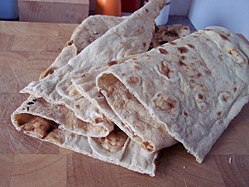 Fugazza con queso | |
| Type | Flatbread |
|---|---|
| Place of origin | Argentina |
| Region or state | Buenos Aires |
| Serving temperature | Hot or warm |
| Main ingredients | Dough, onions, cheese |
| Part of a series on |
| Pizza |
|---|
 |

Fugazza (from Genoese: fugassa) is a common type of Argentine pizza, originating in Buenos Aires, [1] that consists of a thick pizza crust topped with onions and sometimes olives. A similar variant known as fugazza con queso or americana includes mozzarella cheese along with the aforementioned ingredients. It is derived from a combination of Neapolitan pizza with Italian focaccia bread.
Contents
Fugazza and its variations are believed to have been invented sometime between 1893 and 1932 by pizza maker Juan Banchero, who served it out of a pizza shop bearing his name. [2]
